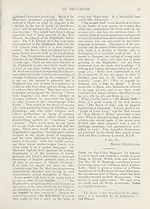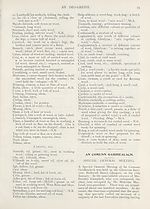An Comunn Gàidhealach Publications > Deo-gréine > Volume 3, October 1907-September 1908
(92) Page 94
Download files
Complete book:
Individual page:
Thumbnail gallery: Grid view | List view

94
AN DKO-GREINE.
TECHNICAL TERMS CONNECTED
WITH WOMEN’S WORK.
The second competition in the collection of
Technical Terms took place at the ninth Mod
held at Perth in the year 1900, and on that
occasion the department of women’s work in
all the branches of yarn and cloth making,
dairying and house-work was prescribed to
competitors. The highest honours were carried
off by Mrs. K. W. Grant, a frequent prize¬
winner, with a paper sent, if we remember
well, all the way from the Antipodes. The
nom-de-plume “ Latharna ” (Lome) employed
by her indicates the quarter of Gaeldom
to which what is distinctive in her paper
is likely to belong. The greater part of
her paper, which is in literary form with
lists of terms added, has already appeared in
print. Another prize-winner on this as on
many other occasions, was the Rev. Neil Ross,
and his paper contributing especially what is
distinctive of Skye, as well as a paper by the
present editor will be incorporated in the
following lists. A large proportion of the
terms is common to all three papers and are
to be found in the usual authorities. After less
known terms, however, that have been rescued
from oblivion by this competition, the initals
“ K.W.” will be added if from Mrs. Grant’s
paper, and “ N.R.” if from that of the Rev.
Neil Ross. When several terms with their
explanations are taken in succession from the
same paper, the whole group will be placed
within quotation marks and the proper initials
given once only at the end. Those initials
will be used also to assign quotations to their
source. Other convenient abbreviations will
be H.S.D. for the Highland Society’s Diction¬
ary, Arm. for Armstrong’s, McL. for Macleod
and Dewar’s, McA. for MacAlpine’s, McE. for
MacEachen’s (2nd edition) McD. for the new
Faclair Gaidhlig le Dealbhan not yet completed,
and McB. for MacBain’s. Ed.T.T. will be used
for “ editor of Technical Terms.”
Wool-working.
Galanas, spinning, working of wool, flax,
hemp, etc., manufacture of cloth.
Abhras, wool, flax, or other materials for
cloth manufacture, yarn, worsted ; manual
produce.
Abhrasach, spinning woolengaged in home
or house thrift; well supplied with materials
for the manufacture of cloth.
Abhrasaiche, a worker of wool or flax, manu¬
facturer of cloth.
Wool.
Olann, wool; sometimes olainn, olunn.
Olla, woollen ; aodach olla, woollen cloth or
woollen clothes; snath olla, woollen yarn,
worsted. Though called, and translated as,
an adjective by some authorities the word,
which is for olna or ollna like uillne, from
uileann, elbow, is a genitive of olann ; of
uilleadh na h-olla, sub. The genitive cf
olann in Irish is olna or olla.
Cloimh, cliiimh, plumage, down ; in some
places, wool.
Eanach, down ; scurf; wool, etc.
Ollach, woolly, fleecy.
Cloimheach, idem ; downy.
Lomradh, a fleece.
Lomar, lomairt, idem.
Rusg, idem ; bark of a tree, etc.
Marbhchann, a morling, flayed skin of a-sheep ;
wool from a dead sheep ; sometimes march-
ann, marachann, etc. From marbh, dead, and
jcionn, skin, as in craicionn, boicionn, etc.
Olann - mharbhchainn, wool from a dead
sheep.
Marbhtach, idem.—N.R.
“ Spiontach, skin wool, Perthshire.''—McA.
Spiol, pluck (wool from a morling, etc.) “ A
skin of this sort [marbhchann] is often washed
first in the strong lye in which clothes have
been steeped for the wash. It is washed in
each graith (Scot.) or lather, as the clothes
are taken out, and, after rinsing, hung on a
pailing to drip, and nearh/ dry. When a
skin is sufficiently dry to be plucked it is
placed on the back of a chair near the fire—
the warmth makes the plucking easier—
with a clean- creel underneath into which
the tufts of wool fall as they are plucked.
The cutch, or coarse wool, remains on the
skin, if the fingers are deft enough. The
wool is then either teased for the carding, or
dyed, should it be needed for mixtures.
This kind of wool is not generally con¬
sidered so excellent as that shorn from the
sheep, but serves admirably for tweeds, or
for dyeing and mixing with the better
quality of wool in common use.”—K.W.
The following lucid and helpful outline •
of the process of manufacturing wool is also
from Mrs. Grant’s paper.
“ It will prevent confusion if the several
steps of the process of manufacture are noted
at the beginning.
1 Seorsachadh na cloimhe, assorting the
different qualities.
2 Nigheadh na cloimhe, cleansing the wool.
3 Tiormachadh, drying.
4 Cireadh, combing or teasing.
5 Armadh, anointing, greasing.
6 Cardadh, carding, combing.
7 Sniomh, spinning.
8 Croiseadh an t-snatha, reeling into hanks.
9 Dathadh an t-snatha, dyeing the yarn.
10 Tachras, winding into balls.
11 Figheadh, weaving into cloth.
AN DKO-GREINE.
TECHNICAL TERMS CONNECTED
WITH WOMEN’S WORK.
The second competition in the collection of
Technical Terms took place at the ninth Mod
held at Perth in the year 1900, and on that
occasion the department of women’s work in
all the branches of yarn and cloth making,
dairying and house-work was prescribed to
competitors. The highest honours were carried
off by Mrs. K. W. Grant, a frequent prize¬
winner, with a paper sent, if we remember
well, all the way from the Antipodes. The
nom-de-plume “ Latharna ” (Lome) employed
by her indicates the quarter of Gaeldom
to which what is distinctive in her paper
is likely to belong. The greater part of
her paper, which is in literary form with
lists of terms added, has already appeared in
print. Another prize-winner on this as on
many other occasions, was the Rev. Neil Ross,
and his paper contributing especially what is
distinctive of Skye, as well as a paper by the
present editor will be incorporated in the
following lists. A large proportion of the
terms is common to all three papers and are
to be found in the usual authorities. After less
known terms, however, that have been rescued
from oblivion by this competition, the initals
“ K.W.” will be added if from Mrs. Grant’s
paper, and “ N.R.” if from that of the Rev.
Neil Ross. When several terms with their
explanations are taken in succession from the
same paper, the whole group will be placed
within quotation marks and the proper initials
given once only at the end. Those initials
will be used also to assign quotations to their
source. Other convenient abbreviations will
be H.S.D. for the Highland Society’s Diction¬
ary, Arm. for Armstrong’s, McL. for Macleod
and Dewar’s, McA. for MacAlpine’s, McE. for
MacEachen’s (2nd edition) McD. for the new
Faclair Gaidhlig le Dealbhan not yet completed,
and McB. for MacBain’s. Ed.T.T. will be used
for “ editor of Technical Terms.”
Wool-working.
Galanas, spinning, working of wool, flax,
hemp, etc., manufacture of cloth.
Abhras, wool, flax, or other materials for
cloth manufacture, yarn, worsted ; manual
produce.
Abhrasach, spinning woolengaged in home
or house thrift; well supplied with materials
for the manufacture of cloth.
Abhrasaiche, a worker of wool or flax, manu¬
facturer of cloth.
Wool.
Olann, wool; sometimes olainn, olunn.
Olla, woollen ; aodach olla, woollen cloth or
woollen clothes; snath olla, woollen yarn,
worsted. Though called, and translated as,
an adjective by some authorities the word,
which is for olna or ollna like uillne, from
uileann, elbow, is a genitive of olann ; of
uilleadh na h-olla, sub. The genitive cf
olann in Irish is olna or olla.
Cloimh, cliiimh, plumage, down ; in some
places, wool.
Eanach, down ; scurf; wool, etc.
Ollach, woolly, fleecy.
Cloimheach, idem ; downy.
Lomradh, a fleece.
Lomar, lomairt, idem.
Rusg, idem ; bark of a tree, etc.
Marbhchann, a morling, flayed skin of a-sheep ;
wool from a dead sheep ; sometimes march-
ann, marachann, etc. From marbh, dead, and
jcionn, skin, as in craicionn, boicionn, etc.
Olann - mharbhchainn, wool from a dead
sheep.
Marbhtach, idem.—N.R.
“ Spiontach, skin wool, Perthshire.''—McA.
Spiol, pluck (wool from a morling, etc.) “ A
skin of this sort [marbhchann] is often washed
first in the strong lye in which clothes have
been steeped for the wash. It is washed in
each graith (Scot.) or lather, as the clothes
are taken out, and, after rinsing, hung on a
pailing to drip, and nearh/ dry. When a
skin is sufficiently dry to be plucked it is
placed on the back of a chair near the fire—
the warmth makes the plucking easier—
with a clean- creel underneath into which
the tufts of wool fall as they are plucked.
The cutch, or coarse wool, remains on the
skin, if the fingers are deft enough. The
wool is then either teased for the carding, or
dyed, should it be needed for mixtures.
This kind of wool is not generally con¬
sidered so excellent as that shorn from the
sheep, but serves admirably for tweeds, or
for dyeing and mixing with the better
quality of wool in common use.”—K.W.
The following lucid and helpful outline •
of the process of manufacturing wool is also
from Mrs. Grant’s paper.
“ It will prevent confusion if the several
steps of the process of manufacture are noted
at the beginning.
1 Seorsachadh na cloimhe, assorting the
different qualities.
2 Nigheadh na cloimhe, cleansing the wool.
3 Tiormachadh, drying.
4 Cireadh, combing or teasing.
5 Armadh, anointing, greasing.
6 Cardadh, carding, combing.
7 Sniomh, spinning.
8 Croiseadh an t-snatha, reeling into hanks.
9 Dathadh an t-snatha, dyeing the yarn.
10 Tachras, winding into balls.
11 Figheadh, weaving into cloth.
Set display mode to:
![]() Universal Viewer |
Universal Viewer | ![]() Mirador |
Large image | Transcription
Mirador |
Large image | Transcription
| An Comunn Gàidhealach > An Comunn Gàidhealach Publications > Deo-gréine > Volume 3, October 1907-September 1908 > (92) Page 94 |
|---|
| Permanent URL | https://digital.nls.uk/125335696 |
|---|
| Description | Leabhar 3, An Damhair 1907 gu Mìos Meadhonach an Fhoghair 1908 |
|---|---|
| Attribution and copyright: |
|
| Description | This contains items published by An Comunn, which are not specifically Mòd-related. It includes journals, annual reports and corporate documents, policy statements, educational resources and published plays and literature. It is arranged alphabetically by title. |
|---|
| Description | A collection of over 400 items published by An Comunn Gàidhealach, the organisation which promotes Gaelic language and culture and organises the Royal National Mòd. Dating from 1891 up to the present day, the collection includes journals and newspapers, annual reports, educational materials, national Mòd programmes, published Mòd literature and music. |
|---|---|
| Additional NLS resources: |
|

